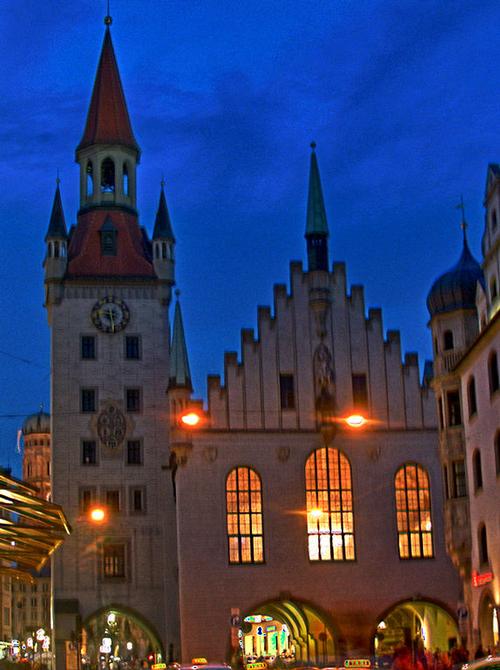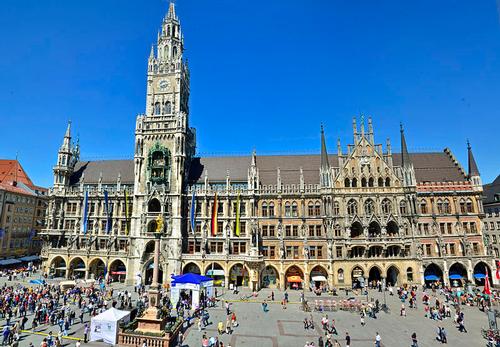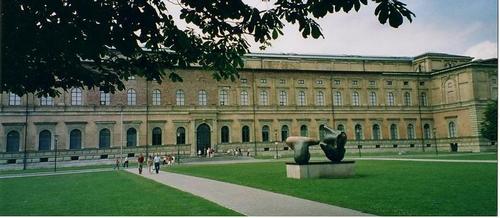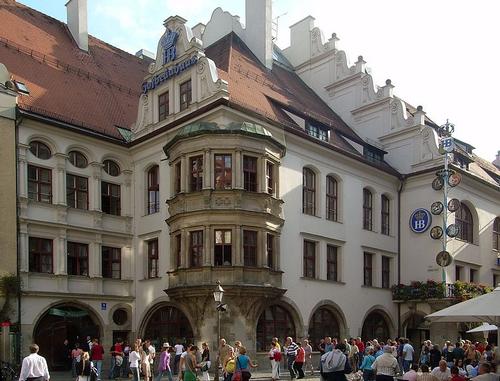BAVARIA
Munich

Munich
Munich
Munich is the capital and largest city of the German state of Bavaria. The city lies on the River Isar in the north of the Bavarian Alps. Munich is the third largest city in Germany. About 1,420,000 people live within the city limits. Munich was the host city of the 1972 Summer Olympics. The name of the city comes from monks of the Benedictine order who founded the city. The city's coat of arms contains a small sketch of a monk. According to the 2011 census, the city of Munich had 1,378,176 inhabitants. Modern Munich is a financial center. The city is an attractive migration destination. Munich old townhall in the nightPhoto: Richard Huber CC 3.0 Unported no changes made
Munich old townhall in the nightPhoto: Richard Huber CC 3.0 Unported no changes made
| advertisement |
| Hotels Munich |
Location
Munich is located on the elevated plain of Upper Bavaria, at an altitude of about 520 meters. The metropolitan area covers 310.43 km². The local rivers are the Isar and the Würm. The northern part of this sandy plateau is very fertile. Munich consists of 25 city districts.
Weather
Munich has a humid continental climate with warm summers. Usually the hottest month of the year is July, the coolest month of the year is January. Thunderstorms can occur in late spring and during the summer months and provide the highest rainfall. June is the rainiest month of the year. In Munich it rains and snows more than in many other parts of Germany due to its elevated position near the Alps. The Alps also provide a warm wind (the foehn). This wind blows from the Alps and can raise the temperature significantly even in winter. Weather conditions fluctuate more often than in other parts of Germany. The number of hours of sunshine per year is approximately 1708. The highest and lowest temperatures ever recorded are 37.1 °C on August 13, 2003 and -30.5 °C on January 21, 1942.
History
In a document signed in Augsburg in the year 1158, the city of Munich was mentioned for the first time. Munich was officially given city status in 1175. Munich became the ducal residence of Upper Bavaria in 1255, when the Duchy of Bavaria was divided into two parts. Munich was declared the capital. Bavaria was reunited in 1506. During the 16th century Munich was a center of the German Counter-Reformation and of Renaissance art. In 1806 the city became the capital of the new Kingdom of Bavaria. Many of the city's most beautiful buildings belong to this period and were built under the first three Bavarian kings.
After the outbreak of the First World War in 1914, life in Munich became very difficult. One reason was the Allied blockade of Germany. This created food and fuel shortages. Munich was badly damaged by Allied bombing during World War II. After the American occupation in 1945, the destroyed city was completely rebuilt according to the original city plan. Today, the residents of Munich enjoy a high quality of life.
 Munich Town hallPhoto: Guido Radig CC 3.0 Unported no changes made
Munich Town hallPhoto: Guido Radig CC 3.0 Unported no changes made
Sights
The city is an inspiring mix of historic buildings and impressive architecture as the ruins of the historic buildings were reconstructed and new structures built. The Marienplatz, a historic square in Munich, is the heart of the city. Both the old town hall and the new town hall can be found here. The Cathedral of Our Lady is one of the most famous sights in Munich. It was built between 1468 and 1488. Three city gates of the original five gates that were part of the city's fortifications have been preserved: the Isartor, the Karlstor and the Sendlinger Tor. Karlsplatz is a square located on the western side of Munich's inner city. It was built at the end of the 18th century, when the medieval walls surrounding the city were demolished. Karolinenplatz is a star-shaped square, located close to the more monumental Königsplatz.
Munich's Old Town Hall was originally built in the 15th century in the Gothic style. After it was destroyed during World War II, the building has been restored to its original plans. It currently houses a toy museum. The New Town Hall, known for its chimes or carillon, is one of the city's most prominent landmarks. It was built between 1867 and 1909 when the old town hall became too small for the growing city.
Munich has many well-known museums, Kunstareal is the museum quarter in Munich, home to over ten different museums, from photo galleries and ancient art museums to geological and natural history museums. The Deutsches Museum is the largest technological museum of its kind. The exhibits cover topics ranging from mining and agriculture to telecommunications and aerospace.
 Munich Alte PinakothekPhoto: Markus Würfel CC 3.0 Unported no changes made
Munich Alte PinakothekPhoto: Markus Würfel CC 3.0 Unported no changes made
The Alte Pinakothek is one of the most famous museums in the world, with an impressive collection of paintings from the 14th to the 18th century. The German, Flemish and Dutch schools are particularly well represented. The Residenz Palace was originally the residence of the Bavarian monarchs. Today it is a large museum with more than a hundred rooms with works of art. The BMW Museum is housed in an annex to the famous car company's headquarters near the Olympiapark.
A number of other places of interest are:
Schloß Nymphenburg is a beautiful palace set in a large park, originally built in the 17th century. St. Peter's Church is the oldest in the city of Munich. The church has an observation platform from which you have a beautiful view over the city.
The Olympia Park was the site of the 1972 Olympic Games in Munich. It is most famous for its tent-like structures, in particular the Olympic Stadium.
The Königsplatz is a historic open square originally established as a "forum for the arts". The square is dominated by three classical Greek buildings.
The Theatinerkirche is a beautiful church built in the Italian Baroque style in the 17th century. It was built in honor of the long-awaited birth of the new prince, Max Emanuel.
The Siegestor was built in the mid-19th century to commemorate the victory of the Bavarian army in the Napoleonic War.
Tips
 Munich HofbräuhausPhoto: Public Domain
Munich HofbräuhausPhoto: Public Domain
For two weeks, the Oktoberfest draws millions of people to beer tents and fairground entertainment. Munich Hofbräuhaus - the world's most famous beer hall - was originally founded in the late 16th century. It is one of the most popular beer halls during the Oktoberfest.
Munich is a green city with many parks. The Englischer Garten, close to the city center, covering an area of 3.7 km² (larger than New York's Central Park), is one of the world's largest urban public parks.
Useful links Munich
BBC Country ProfilesWorld Fact Book Explore all Countries
How to call
Last updated June 2025
Copyright: Team - The World of Info